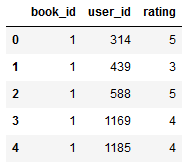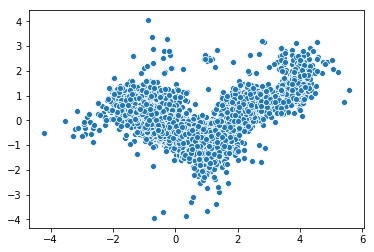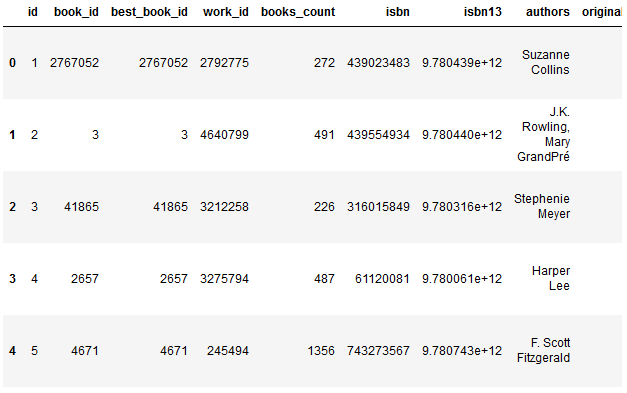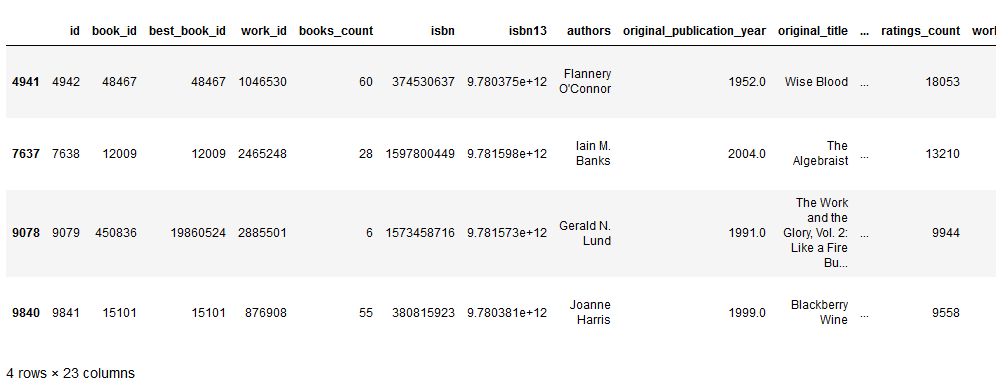Building a book Recommendation System using Keras

Build a system that is able to recommend books to users depending on what books they have already read using the Keras deep learning library.
A recommendation system seeks to predict the rating or preference a user would give to an item given his old item ratings or preferences. Recommendation systems are used by pretty much every major company to enhance the quality of their services.
In this article, we will look at how to use embeddings to create a book recommendation system.
We will use the goodbooks-10k dataset, containing ten thousand different books and about one million ratings. It has three features—the book_id, user_id, and rating. If you don’t want to download the dataset from Kaggle yourself, you can get the file and the complete code covered in this article from my Github repository.
Embedding
An embedding is a mapping from discrete objects, such as words or ids of books in our case, to a vector of continuous values. This can be used to find similarities between the discrete objects that wouldn’t be apparent to the model if it didn’t use embedding layers.
The embedding vectors are low-dimensional and get updated while training the network. The image below shows an example of embedding created using Tensorflows Embedding Projector.

Getting data
Pandas will be used for loading the dataset into memory. Then the data will be split into a training and testing set, and we will create two variables that give us the unique number of users and books.
dataset = pd.read_csv('ratings.csv')
train, test = train_test_split(dataset, test_size=0.2, random_state=42)
n_users = len(dataset.user_id.unique())
n_books = len(dataset.book_id.unique())
The dataset is already cleaned, so we don’t need to take further data cleaning or preprocessing steps.
Creating Embedding Model
The Keras deep learning framework makes it easy to create neural network embeddings as well as working with multiple input and output layers.
Our model will have the following structure:
- Input: Input for both books and users
- Embedding Layers: Embeddings for books and users
- Dot: combines embeddings using a dot product
In an embedding model, the embeddings are the weights learned during training. Therefore, these embeddings can not only be used for extracting information about the data but can also be extracted and visualized.
For simplicity reasons, I didn’t add any fully-connected layers at the end, even though this could have increased the accuracy by quite a bit. So if you want a more accurate model, this is something to try out.
Below is the code for creating the model:
from tensorflow.keras.layers import Input, Embedding, Flatten, Dot, Dense
from tensorflow.keras.models import Model
book_input = Input(shape=[1], name="Book-Input")
book_embedding = Embedding(n_books+1, 5, name="Book-Embedding")(book_input)
book_vec = Flatten(name="Flatten-Books")(book_embedding)
user_input = Input(shape=[1], name="User-Input")
user_embedding = Embedding(n_users+1, 5, name="User-Embedding")(user_input)
user_vec = Flatten(name="Flatten-Users")(user_embedding)
prod = Dot(name="Dot-Product", axes=1)([book_vec, user_vec])
model = Model([user_input, book_input], prod)
model.compile('adam', 'mean_squared_error')Training the model
Now that we have created our model, we are ready to train it. Because we have two input layers (one for the books and one for the users), we need to specify an array of training data as our x data. For this article, I trained the model for ten epochs, but you can train it longer to get better results.
Below is the training code:
history = model.fit([train.user_id, train.book_id], train.rating, epochs=10, verbose=1)
model.save('regression_model.h5')Visualizing embeddings
Embeddings can be used to visualize concepts such as the relation of different books in our case. To visualize these concepts, we need to reduce dimensionality further using dimensionality reduction techniques like principal component analysis (PSA) or t-distributed stochastic neighbor embedding (TSNE).
Starting with 10000 dimensions (one for each book), we map them to 5 dimensions using embedding and then further map them to 2 dimensions using PCA or TSNE.
First, we need to extract the embeddings using the get_layer function:
# Extract embeddings
book_em = model.get_layer('Book-Embedding')
book_em_weights = book_em.get_weights()[0]Now we will use PCA to transform our embeddings to 2 dimensions and then scatter the results using Seaborn:
from sklearn.decomposition import PCA
import seaborn as sns
pca = PCA(n_components=2)
pca_result = pca.fit_transform(book_em_weights)
sns.scatterplot(x=pca_result[:,0], y=pca_result[:,1])
The same can be done using TSNE:
from sklearn.manifold import TSNE
tsne = TSNE(n_components=2, verbose=1, perplexity=40, n_iter=300)
tnse_results = tsne.fit_transform(book_em_weights)
sns.scatterplot(x=tnse_results[:,0], y=tnse_results[:,1])
Making Recommendations
Making recommendations using our trained model is simple. We only need to feed in a user and all books and then select the books which have the highest predicted ratings for that specific user.
The code below shows the process of making predictions for a specific user:
# Creating dataset for making recommendations for the first user
book_data = np.array(list(set(dataset.book_id)))
user = np.array([1 for i in range(len(book_data))])
predictions = model.predict([user, book_data])
predictions = np.array([a[0] for a in predictions])
recommended_book_ids = (-predictions).argsort()[:5]
print(recommended_book_ids)
print(predictions[recommended_book_ids])This code outputs:
array([4942, 7638, 8853, 9079, 9841], dtype=int64)
array([5.341809 , 5.159592 , 4.9970446, 4.9722786, 4.903894 ], dtype=float32)We can use the book ids to get more information about the books using the books.csv file.
books = pd.read_csv(‘books.csv’)
books.head()
print(books[books[‘id’].isin(recommended_book_ids)])
Conclusions
Embeddings are a method of mapping from discrete objects, such as words, to vectors of continuous values. They are useful for finding similarities, visualization purposes, and as an input into another machine learning model.
This example certainly isn’t perfect, and many things can be tried to improve performance. But for more advanced problems, it is a good starting point for learning how to use embeddings.
Here are a few things you could add to get better results:
- Add fully-connected layers after the dot product
- Train for more epochs
- Scale the rating column
- etc.